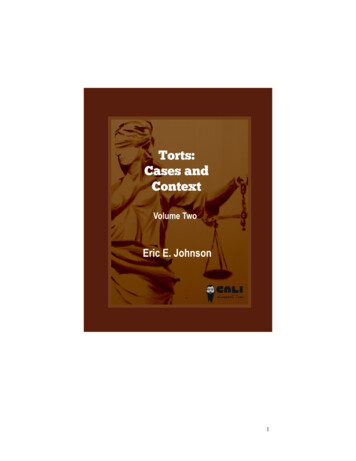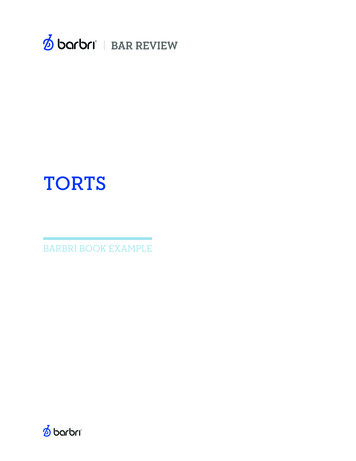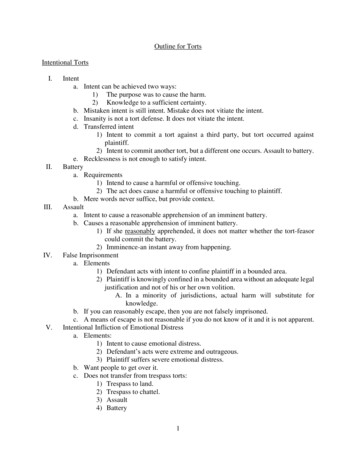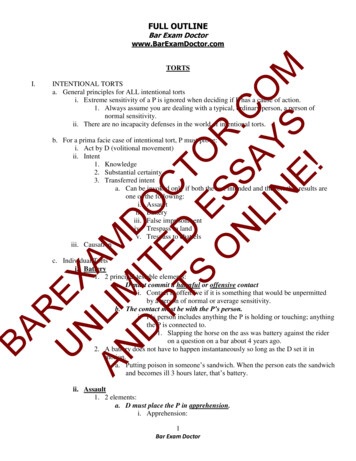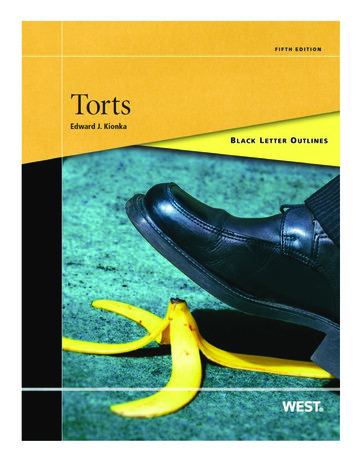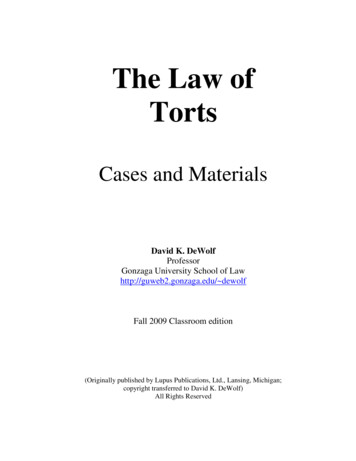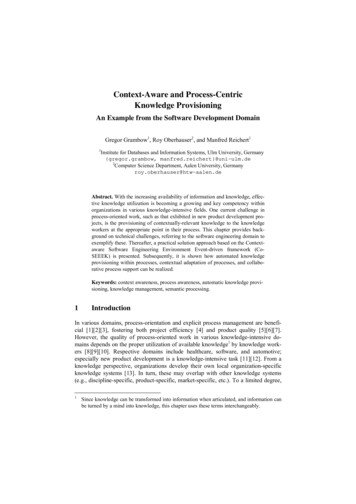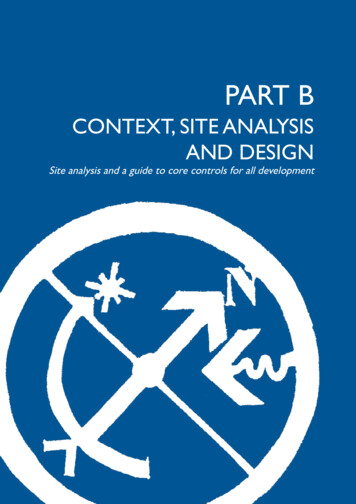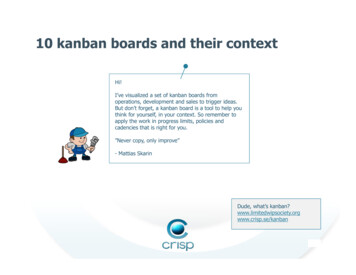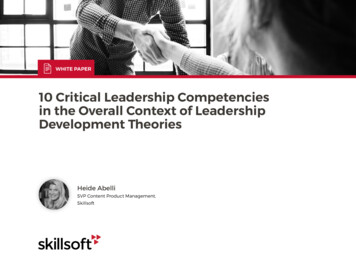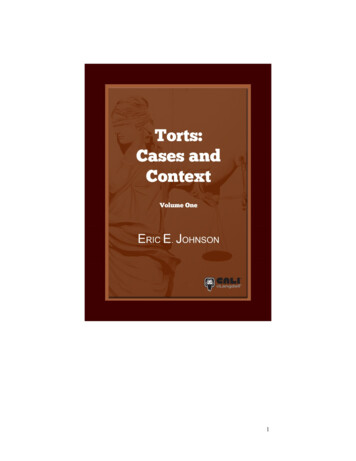
Transcription
1
Torts:Cases and ContextVolume OneEric E. JohnsonAssociate Professor of LawUniversity of North Dakota School of LaweLangdell Press 2015
About the AuthorEric E. Johnson is an Associate Professor of Law at the Universityof North Dakota. He has taught torts, intellectual property, sales,entertainment law, media law, sports law, employment law, andwriting courses. He has twice been selected by students as thekeynote speaker for UND Law’s graduation banquet. His writing onlegal pedagogy has appeared in the Journal of Legal Education.With scholarly interests in science and risk, and in intellectualproperty, Eric’s publications include the Boston University Law Review,the University of Illinois Law Review, and New Scientist magazine. Hiswork was selected for the Yale/Stanford/Harvard Junior FacultyForum in 2013.Eric’s practice experience includes a wide array of business torts,intellectual property, and contract matters. As a litigation associate atIrell & Manella in Los Angeles, his clients included Paramount,MTV, CBS, Touchstone, and the bankruptcy estate of eToys.com.As in-house counsel at Fox Cable Networks, he drafted andnegotiated deals for the Fox Sports cable networks.Eric received his J.D. cum laude from Harvard Law School in 2000,where he was an instructor of the first-year course in legal reasoningand argument. He received his B.A. with Highest and SpecialHonors from the Plan II program at the University of Texas atAustin.Outside of his legal career, Eric performed as a stand-up comic andwas a top-40 radio disc jockey. Eric archives teaching materials onhis website at ericejohnson.com. His online exam archive includesmore than a dozen torts essay exams and a bank of multiple-choicequestions.i
For Joe and Zaneii
NoticesThis is the first edition of this casebook, updated December 2015.Visit http://elangdell.cali.org/ for the latest version and for revisionhistory.This work (but not including the cover art, CALI logo, and eLangdelllogo) is authored by Eric E. Johnson, published by CALI eLangdellPress, and licensed under a Creative Commons AttributionShareAlike 4.0 International License (CC BY-SA 4.0). 2015 CALI.All rights not expressly granted by this Creative Commons license arereserved. No copyright is asserted in U.S. Government works orother public domain material included herein.In brief, the terms of the license are that you may copy, distribute,and display this work, or make derivative works, so long as you give CALI eLangdell Press and the author credit; and you distribute any works derived from this one under thesame licensing terms as this.Suggested attribution format for original work:Eric E. Johnson, Torts: Cases and Context, Volume 1, 2015, publishedby CALI eLangdell Press. Available under a Creative Commons BYSA 4.0 License.This book is konomarked – requests for gratis permissions beyondthe scope of the Creative Commons license are welcomed. Contactfeedback@cali.org.CALI and eLangdell are United States federally registeredtrademarks owned by the Center for Computer-Assisted LegalInstruction. The cover art design is a copyrighted work of CALI, alliii
rights reserved. The CALI graphical logo is a trademark and may notbe used without permission.Should you create derivative works based on the text of this book orother Creative Commons materials therein, you may not use thisbook’s cover art and the aforementioned logos, or any derivativethereof, to imply endorsement or otherwise without writtenpermission from CALI.This material does not contain nor is it intended to be legal advice.Users seeking legal advice should consult with a licensed attorney intheir jurisdiction. The editors have endeavored to provide completeand accurate information in this book. However, CALI does notwarrant that the information provided is complete and accurate.CALI disclaims all liability to any person for any loss caused by errorsor omissions in this collection of information.iv
About eLangdell PressThe Center for Computer-Assisted Legal Instruction (CALI ) is anonprofit organization with over 200 member US law schools, aninnovative force pushing legal education toward change for thebetter. There are benefits to CALI membership for your school, firm,or organization. eLangdell is our electronic press with a mission topublish more open books for legal education.How do we define “open?” Compatibility with devices like smartphones, tablets, and ereaders; as well as print. The right for educators to remix the materials through morelenient copyright policies. The ability for educators and students to adopt the materialsfor free.Find available and upcoming eLangdell titles at elangdell.cali.org.Show support for CALI by following us on Facebook and Twitter,and by telling your friends and colleagues where you received yourfree book.v
Table of ContentsTorts, Volume One. 2About the Author . iNotices . iiiAbout eLangdell Press . vPreface . 14Acknowledgements . 20Part I: Preliminaries. 221. Basic Concepts . 23What is Torts? . 23How Torts Fits In . 24The Elemental Concepts of Private Law . 26Where Tort Law Comes From. 27The Structure of a Tort Case. 31The Parties . 31Causes of Action, Elements, Affirmative Defenses, and Burdensof Proof . 312. An Overview of Tort Law . 35The Lineal Torts – Direct Harm to Persons or Physical Property . 36Causes of Action for Accidents . 36Strict Liability . 38Intentional Torts . 39The Oblique Torts – Economic or Dignitary Harm . 44The Whole Torts Landscape Considered Together . 46Part II: Negligence . 473. Introduction to Negligence . 48Introduction . 48The Central Idea: Shifting the Burden of Loss . 48The Elements and Defenses for Negligence . 494. An Example of a Negligence Case . 556
Check-Your-Understanding Questions About Georgetown v. Wheeler725. When and to Whom is a Duty of Care Owed . 73Introduction . 73The Essential Concept: Foreseeability . 74Case: Weirum v. RKO . 74Questions to Ponder About Weirum v. RKO. 80Some Historical Notes About Weirum v. RKO . 80Doctrinal Wiggle Room . 81Duty of Care in Entertainment Industry Cases . 82Problem: WZX Cash Patrol . 82Case: Kubert v. Colonna. 83The Duty of Care and Criminal Acts . 95Case: Boyd v. Racine Currency Exchange . 95Questions to Ponder About Boyd . 100The Use of Boyd to Decide Duty in Orrico v. Beverly Bank . 100Affirmative Duties . 101The General Rule: No Affirmative Duty to Help . 102Case: Yania v. Bigan . 102Questions to Ponder about Yania . 105Case: Theobald v. Dolcimascola. 105Questions to Ponder About Theobald . 110The Exception of Defendant-Created Peril . 110Case: South v. Amtrak. 111Questions to Ponder About South v. Amtrak . 119Weather and “Atmospherics” . 119Evidence Law and Procedural Posture. 120Note About the Interpretation of Statutes . 120“Good Samaritan” Laws . 121The Exception for Special Relationships . 122The Exception for Assumption of Duty. 123The Tarasoff Exception . 124Case: Tarasoff v. UC Regents . 1247
Questions to Ponder About Tarasoff . 1366. Breach of the Duty of Care. 137Determining Breach, in General . 137Terminology Note: Negligence vs. Negligence . 137The Essential Question: Was the Risk Unreasonable? . 138Distinguishing Breach from the Other Elements . 139Case: Rogers v. Retrum . 139Intentional Conduct as a Breach of Duty . 147The Reasonable Person Standard of Care . 150Basics. 150An Objective Standard . 152Case: Vaughn v. Menlove . 152Accounting for Differences Among People . 156Basics. 156Mental and Physical Capacity and Disability . 157Case: Breunig v. American Family Insurance Co. . 157Experience and Level of Skill . 162Children . 163Gender . 165Some Questions to Ponder About the Reasonable PersonStandard . 166Negligence Per Se. 167Basics. 167What Makes a Statute or Regulation Amenable. 168Case: Gorris v. Scott . 170Negligence Per Se and Contributory/Comparative Negligence. 173Negligence Per Se and Causation . 173Case: Martin v. Herzog . 174Excuse for Complying with a Statute or Regulation . 186Complying with Statutes or Regulations as a Defense. 187Some Problems on Negligence Per Se . 188The Role of Custom or Standard Practices. 1908
Case: The T.J. Hooper . 191The Negligence Calculus . 196Introduction . 196Case: U.S. v. Carroll Towing . 197The BPL Formula’s Place in Torts . 202How the BPL Formula Works. 203Some Simple Problems Using the Hand Formula. 207Some Not-So-Simple Problems Using the Hand Formula . 208Res Ipsa Loquitor .
Eric E. Johnson is an Associate Professor of Law at the University of North Dakota. He has taught torts, intellectual property, sales, entertainment law, media law, sports law, employment law, and writing courses. He has twice been selected by students as the keynote speaker for UND Law’s graduation banquet. His writing on
